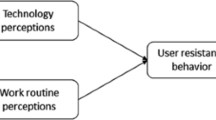Abstract
This paper examines the credibility of the deficit model of resistance to change in a case study on office automation. A functional analysis of resistance to change is conducted using narrative interviews and documentary analysis. Resistance to change is shown to occur and to affect the implementation process: resistance is identified as a useful source of information, directing the attention of the change agency to improve hardware, software, and the organization. User attitudes were found to change: global skepticism developed into critical acceptance of the office system. The decision-making criteria changed during the 3-year period of the case study. More criteria were used, with user-friendliness becoming more prominent in the decision criteria. The case highlights some limitations of Lewinian field theory in studying resistance to change. Systems theory may provide a more useful framework, organized around the principle that resistance to change is a functional selfmonitoring subsystem guiding the internal adjustment of the changing organization and thus securing effectiveness. This approach may have wider implications for the analysis of social change.
Similar content being viewed by others
References
Bauer, M. (1986).Widerstand gegen Neue Technologien, Eine Fallstudie zur Bueroautomation in einem Kleinbetrieb, Skizzen zu einer handlungspsychologischen Konzeption von “Widerstand gegen Veraenderung,” Lizentiat Thesis, Psychological Institute of the University of Berne, April, NCR Foundation, Zurich.
Bechmann, G., Gloede, F., and Paschen, H. (1988). Fruehwarnung vor technikbedingten Gefahren. In Bungard, W., and Lenk, H. (eds.)Technikbewertung, Suhrkamp, Frankfurt.
Boehnisch, W. (1979).Personale Widerstaende bei der Durchsetzung von Innovationen, Poeschel, Stuttgart.
Brotherton, C. (1988). Editorial: Technological change and innovation-setting the agenda for occupational psychology.J. Occupat. Psychol. 61, 1–5.
Coch, L., and French, J. R. P. (1948). Overcoming resistance to change.Hum. Relat. 1, 512–532.
Cranach, M. V., and Harre, R. (eds.) (1982).The Analysis of Action. Recent Theoretical and Empirical Advances, Cambridge University Press, Cambridge.
Cranach, M. V., and Ochsenbein, G. (1985). Self-monitoring systems: Their function in human information processing and action. A paper given at Karl-Marx University, Leipzig, Dec. 1984. [Schweiz. Z. Psychol. 44, 221–235, 1985 (in German).]
Crozier, M., and Friedberg, E. (1979).Macht und Organisation. Die Zwaenge des kollektiven Handelns, Athenaeum, Koenigstein.
Farr, R. M., and Moscovici, S. (eds.) (1984).Social Representations, Cambridge University Press, Cambridge.
Frank, J. D. (1944). Experimental studies of personal pressure and resistance.J. Gen. Psychol. 30, 23–64.
Gerl, K. (1975).Analyse, Erfassung und Handhabung von Anpassungswiderstaenden beim organisationalen Wandel, Dissertation, Universitaet Muenchen, Muenchen.
Greif, S. (1983).Konzepte der Organisationspsychologie. Eine Einfitehrung in grundlegende theoretische Ansaetze, Huber, Bern.
Greif, S., Holling, H., and Nicholson, N. (eds.) (1989).Arbeits-und Organisationspsychologie, Psychologie Verlags Union, Muenchen.
Hagerstrand, T. (1967).Innovation Diffusion as a Spatial Process, Chicago University Press, Chicago.
Himmelweit, H. T. (1990). Societal psychology: Implications and scope. In Himmelveit, H. T., and Gaskell, G. (eds.),Societal Psychology, Sage, Newbury Park.
Hirschheim, R. A., and Newman, M. (1988). Information systems and user resistance. Theory and practice.Comput. J. 31, 5.
Kahn, R. L. (1984). Conclusion: Critical themes in the study of change. In Goodman, P. S. (ed.),Change in Organizations. New Perspectives on Theory, Research and Practice, Jossey-Bass, San Francisco, pp. 409–429.
Klein, D. (1969). Some notes on the dynamics of resistance to change. The defender role. In Bennis, W. G., Benne, K. D., and Chin, R. (eds.),The Planning of Change, 2nd ed., Holt, Rinehart and Winston, New York.
Klein, J. A. (1984). Why supervisors resist employee involvement.Harvard Bus. Rev. 62, 87–95.
Lawrence, P. L. (1954). How to overcome resistance to change.Harvard Bus. Rev. 32, 49–57.
Lewin, K. (1936).Principles of Topological Psychology, McGraw-Hill, New York.
Lewin, K. (1947). Frontiers in group dynamics II.,Hum. Relat. 1, 143–153.
London, I. D. (1944). Psychologists' misuse of the auxiliary concepts of physics and mathematics.Psychol. Rev. 51, 266–291.
Luhmann, N. (1984).Soziale Systeme, Suhrkamp, Frankfurt.
Mahajan, V., and Peterson, R. A. (1985).Models for Innovation Diffusion, Sage University Papers, Beverly Hills.
Markus, M. L. (1983). Power, politics, and MIS implementation.Commun. ACM 26(8), 430–444.
Mayring, P. (1983).Qualitative Inhaltsanalyse, Grundlagen und Techniken, Beltz, Basel.
Mugny, G. (1982).The Power of Minorities, Academic Press, London.
Northcott, J., Fogerty, M., and Trevor, M. (1985).Chips and Jobs: Acceptance of New Technology at Work, Policy Studies Institute, London.
Rouse, W. B., and Morris, N. M. (1986). On looking into the black box: Prospects and limits in the search for mental models.Psychol. Bull. 100(3), 349–363.
Schuetze, F. (1977).Die Technik des narrativen Interviews in Interaktionsfeldstudien, Manuscript, University of Bielefeld, Bielefeld.
Spinas, P., Troy, N., and Ulich, E. (1983).Leitfaden zur Einfuehrung und Gestaltung von Arbeit mit Bildschirmsystemen, Verlag Industrielle OrganisationZurich.
Staw, B. M. (1982). Counterforces to change. In Goodman, P. S. (ed.),Change in Organizations. New Perspectives on Theory, Research and Practice, Jossey-Bass, San Francisco.
TenHorn, L. A. (1989). What has happened to “resistance to change”? The introduction of automation. Paper presented at 4th European Conference of Psychology of Work and Organisation. Cambridge, Apr. 1989.
Watson, G. (1969). Resistance to change. In Bennis, W. G., Benne, K. D., and Chin, R. (eds.),The Planning of Change, 2nd ed., Holt, Rinehart and Winston, New York.
Wells, A. (1987). Social representations and the world of science.J. Theory Soc. Behav. 17 (4), 433–445.
Willcocks, L., and Mason, D. (1987).Computerising Work. People, Systems Design and Workplace Relations, Paradigm, London.
Zander, A. (1961). Resistance to change-its analysis and prevention. In Bennis, W. G., Benne, K. D., and Chin, R. (eds.),The Planning of Change, 1st ed., Holt, Rinehart and Winston, New York, pp. 543–548.
Author information
Authors and Affiliations
Rights and permissions
About this article
Cite this article
Bauer, M. Resistance to change—A monitor of new technology. Systems Practice 4, 181–196 (1991). https://doi.org/10.1007/BF01059564
Received:
Revised:
Issue Date:
DOI: https://doi.org/10.1007/BF01059564




